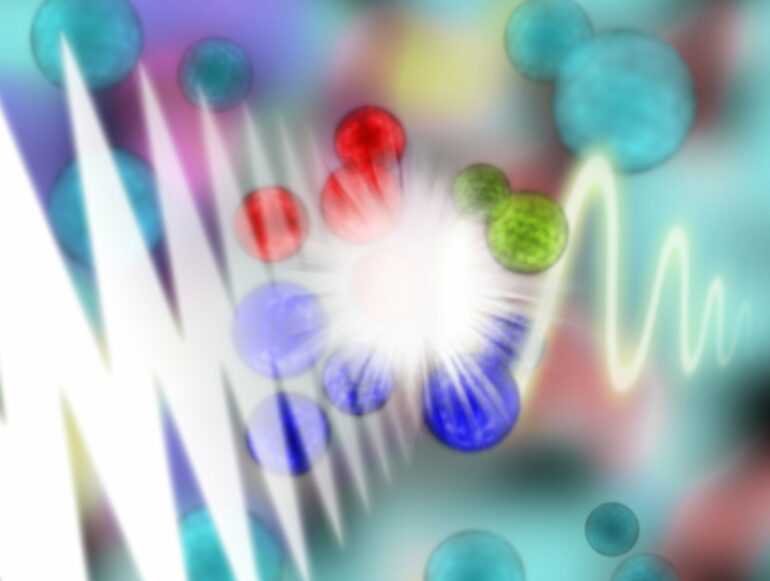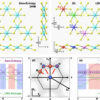When a high-energy photon strikes a proton, secondary particles diverge in a way that indicates that the inside of the proton is maximally entangled. An international team of physicists with the participation of the Institute of Nuclear Physics of the Polish Academy of Sciences in Cracow has just demonstrated that maximum entanglement is present in the proton even in those cases where pomerons are involved in the collisions.
Eighteen months ago, it was shown that different parts of the interior of the proton must be maximally quantum entangled with each other. This result, achieved with the participation of Prof. Krzysztof Kutak from the Institute of Nuclear Physics of the Polish Academy of Sciences (IFJ PAN) in Cracow and Prof. Martin Hentschinski from the Universidad de las Americas Puebla in Mexico, was a consequence of considerations and observations of collisions of high-energy photons with quarks and gluons in protons and supported the hypothesis presented a few years earlier by professors Dimitri Kharzeev and Eugene Levin.
Now, in a paper published in the journal Physical Review Letters, an international team of physicists has been presented a complementary analysis of entanglement for collisions between photons and protons in which secondary particles (hadrons) are produced by a process called diffractive deep inelastic scattering. The main question was: does entanglement also occur among quarks and gluons in these cases, and if so, is it also maximal?
Putting it in simple terms, physicists speak of entanglement between various quantum objects when the values of some feature of these objects are related. Quantum entanglement is not observed in the classical world, but its essence is easily explained by the toss of two coins. Each coin has two sides, and when it falls, it can take one of two mutually exclusive values (heads or tails) with the same probability.
We would be dealing with the analog of quantum entanglement if, when tossing two coins simultaneously, we always obtain either only two different results (heads and tails) or two identical results (two heads or two tails). Here, entanglement would be maximal because no value would be favored—the probability of a coin being in the state of heads or tails would still be 50%. If entanglement were not maximal, the situation would be different.
We would not always observe the same two combinations, but sometimes also the other.
“In nuclear physics, the existence of a maximal entanglement state can be seen in experimental data when looking at it; we know that… we know nothing. In certain collisions of an electron with a proton, called deep inelastic scattering, the proton breaks up completely, and many particles subject to the strong interactions—so-called hadrons—are produced. We are then dealing with a maximally entangled state of the proton whenever we cannot predict how many hadrons will be created in a given collision,” Prof. Kutak explains.
Earlier studies of the maximal entanglement of the proton’s interior addressed the above-mentioned case, where hadrons were produced in the deep inelastic scattering of an electron and a proton. Such reactions are easy to spot in experiments because they result in secondary particles diverging in virtually all directions (i.e., those involving the primary direction of proton motion).
“It is known, however, that roughly every tenth collision occurs differently: behind the collision point, in certain angular intervals, no particles are seen at all. It is precisely such processes that we call diffraction or exclusive production, and they are at the center of our current research into quantum entanglement,” Prof. Kutak adds.
Production in the deep inelastic process results from the interaction of a photon with partons (quarks and gluons) in a proton. In the case of diffractive production, the photon also interacts with a parton in the proton, but one that is part of a larger structure referred to as a pomeron.
The most important quantum feature of gluons is their color (which has nothing to do with color as we know it in everyday life, apart from the name). Secondary particles, observed in detectors as an effect of collisions, are the result of processes in which quarks and gluons in a proton exchange their color charge. However, gluons can form bound states called pomerons, where the color is mutually neutralized.
When, during a collision between a photon and a parton, it turns out that the parton was part of a pomeron, the collision will not produce hadrons diverging over the full angular range covered by the detectors. Instead, some of the detectors, theoretically able to see the particles produced during the collision phase in question, will remain silent.
The international team of physicists was able to show that during collisions involving pomerons, a state is also created inside the proton in which all particles are maximally entangled. However, a difference from the previously analyzed cases is apparent: when pomerons are involved, the maximum entanglement appears at slightly higher energy.
The present research complements our previous knowledge of the course of events during collisions between photons and protons. Thanks to it, it can now be said that maximal entanglement is a universal phenomenon in these processes, present in both secondary particle production mechanisms known to us.
“Our result has not only theoretical, but also practical significance. Indeed, a deeper understanding of how a maximally entangled state is formed inside the proton will allow for a better interpretation of results from future particle colliders such as the Electron-Ion Collider,” concludes Prof. Kutak
More information:
Martin Hentschinski et al, Probing the Onset of Maximal Entanglement inside the Proton in Diffractive Deep Inelastic Scattering, Physical Review Letters (2023). DOI: 10.1103/PhysRevLett.131.241901
Provided by
Polish Academy of Sciences
Citation:
Protons reveal universal phenomenon of maximal entanglement (2024, January 18)



